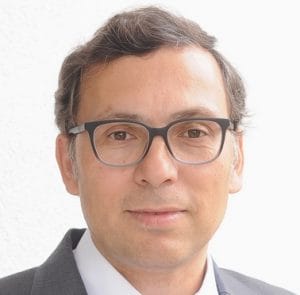The recently arrived 5G architectures will enable a plethora of services and applications never imagined some time ago. However, its complex network infrastructure is prone to suffer cybersecurity attacks that must be tackled in order to ensure users’ privacy and security. In this line, the Horizon-2020-funded INSPIRE-5Gplus project aims at progressing the security vision of 5G & beyond systems by designing and developing a smart, trustworthy and liability-aware security platform for these kinds of systems. To this end, state-of-the-art technologies such as Zero-Touch Network & Service Management (ZSM), Software Defined Security (SD-SEC) modes, Artificial Intelligence (AI)-based techniques, and Trusted Execution Environments (TEE) are being adopted to provide a security aware architecture and its associated closed-loop of security functions.
Continue readingSecurity and Trust in 5G and Beyond
While network security has always been important as a means to protect the physical infrastructure, and the data and content flowing though the network, it is gaining increased attention in the course of 5G and beyond 5G networks, because networks become deeply rooted in our society in the business, governmental and private spaces.
Continue readingEditorial
Dear readers,
5G has further increased the importance of cybersecurity. While network security has already been of high importance, the new usage scenarios enabled by 5G have dramatically increased the stakes. Just think of automated driving and IoT applications in factories, and it becomes clear that network security has become not only a central topic for the ICT domain, but for economy and society as a whole.
In this issue of Eurescom message, we explore what is done in Europe to advance security and trust in 5G and beyond. We present selected research and innovation projects that have contributed to novel solutions for making 5G and future 6G networks more secure.
In the first article of the cover theme, Eurescom message editor Anastasius Gavras gives an overview on security and trust in 5G and beyond. The next article presents 5G PPP project INSPIRE-5Gplus and its holistic security vision for 5G and beyond networks.
In an exclusive interview for Eurescom message, three cybersecurity experts from ENISA share their views on security threats and strategies for 5G and beyond.
In the final article of the cover theme, a team from the 5G-VINNI project present the defence perspective on 5G, adding another dimension to the topic.
This edition of Eurescom message also includes a variety of further articles on different, ICT-related topics. See, for example, the new opinion article by Eurescom director David Kennedy on the drawbacks of working from home in his column “The Kennedy Perspective”. Under “Events”, we report about three important virtual events – the final workshop of 5G PPP infrastructure project 5G EVE, the Joint EuCNC & 6G Summit, and a workshop on liability and accountability organised by the INSPIRE-5Gplus project. See also our “News in brief” section, which features the European Green Digital Coalition and the latest Ericsson report on 5G mobile subscriptions. Finally, in the latest “A bit beyond” article you can learn about the dark side of data.
My editorial colleagues and I hope you will find value in this edition of Eurescom message, and we would appreciate your comments on the current issue as well as suggestions for future issues. Enjoy reading our magazine.
Milon Gupta
Editor-in-chief
AI-NET Kick-Off Event
CELTIC Flagship Project for Intelligent Network Automation
On 1st June 2021, CELTIC flagship project AI-NET was officially launched at a high-level online event. Representatives from the public authorities of Germany, Sweden and Finland as well as representatives of the AI-NET project consortium, comprising major players from industry (large and SMEs), research organisations, and academia, presented the visions and goals of the ambitious European project to an audience of more than 150 participants.
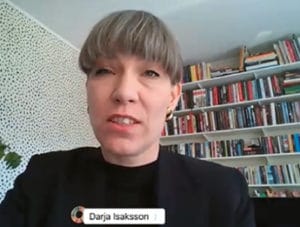
Darja Isaksson, Director General at Vinnova, Sweden’s Innovation Agency
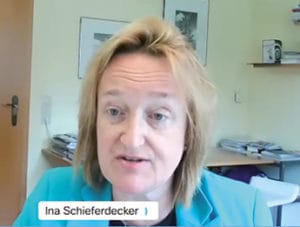
Prof. Dr.-Ing. Ina Schieferdecker, Director-General for Research for Digitalization and Innovation at the German Federal Ministry of Education and Research (BMBF)
AI-NET aims at ‘Accelerating Digital Transformation in Europe with Intelligent Network Automation’. The project is addressing the challenge that the current centralised cloud infrastructure is not adequate for serving the requirements of the digital transformation in Europe. AI-NET is built on the premise that three technologies need to be combined to shape a new secure service and application platform: 5G, edge-centric computing, and artificial intelligence.
The main goal of the AI-NET project is to provide enablers and solutions for high-performance services deployed and operated at the network edge. AI-NET is using artificial intelligence for complementing traditional optimisation algorithms, in order to manage vastly increased network complexity.
The kick-off event was opened by Prof. Dr.-Ing. Ina Schieferdecker, Director-General for Research for Digitalization and Innovation at the German Federal Ministry of Education and Research (BMBF). She said: “AI-NET is an important step for Germany and Europe towards technological sovereignty.”
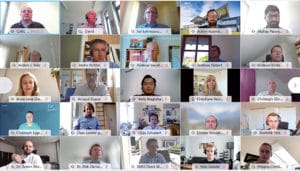
In the following presentations, the representatives of the funding agencies from Sweden and Finland – Darja Isaksson, Director General at Vinnova, Sweden’s Innovation Agency, and Heikki Uusi-Honko, Head of International Networks at Business Finland – shared their views on the importance of AI-NET from the perspective of their national innovation strategies. While Ms Isaksson pointed out that “AI-NET is a cornerstone in Vinnova’s strategy for digital transformation”, Mr Uusi-Honko highlighted the importance of AI-NET for contributing to sustainable growth in Europe. CELTIC-NEXT Vice Chair Jari Lehmusvuori, Head of Department at Nokia Bell Labs, completed the session by presenting the European innovation perspective of Eureka Cluster CELTIC-NEXT.
The next session was dedicated to presenting the AI-NET sub-projects AI-NET-ANIARA, led by Ericsson Research, AI-NET-PROTECT, led by ADVA, and AI-NET-ANTILLAS, led by Nokia Bell-Labs. Magnus Frodigh, Vice President & Head of Ericsson Research, Sweden, Dr. Christoph Glingener, CTO ADVA Optical Networking, Germany, and Patricia Layec, Research Department Head, Nokia Bell-Labs, France, presented the ambition of AI-NET to connect critical infrastructures and data centres through enhanced transport networks and improved networking concepts that will results in reinforced overall security.
The event concluded with a panel discussion on how Europe can accelerate the digital transformation with intelligent network automation. Panelists in the session moderated by Eurescom Director and CELTIC Chairman David Kennedy were Dr. Mohsen Amiribesheli, Research Technology Manager at Konica Minolta Global R&D; Dr. Markus Ohlenforst, Managing Director at IconPro GmbH; Dominik Flick, Project Manager for Energy Performance Management at Stellantis / Opel Automobile GmbH; Dr. Timo Lehnigk-Emden, Managing Director at Creonic GmbH; and Prof. Dr. Jan Juerjens, Director Research Projects at Fraunhofer Institute for Software and Systems Engineering.
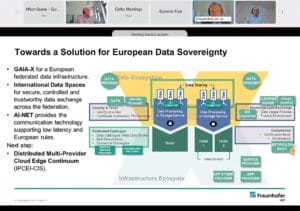
Presentation by Prof. Dr. Jan Jürjens from Fraunhofer ISST
About AI-NET
AI-NET is a 74 million-euro public-private partnership project under CELTIC-NEXT, the EUREKA Cluster for next generation communications for a digital society. AI-NET comprises three sub-projects with 92 companies, research organisations, and universities from Germany, Sweden, Finland, France, United Kingdom, Netherlands, and Poland. The CELTIC-NEXT flagship project is coordinated by ADVA Optical Networking SE, a European telecommunications vendor headquartered in Germany.
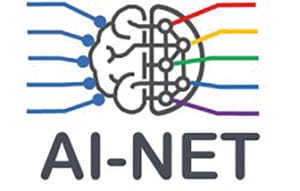
AI-NET is publicly co-funded by the public authorities of Germany (BMBF), Sweden (VINNOVA), Finland (Business Finland), and the United Kingdom (Innovate UK). The project will end in August 2024.
› Further information
› AI-NET Kick-Off Event Page – https://www.celticnext.eu/event/celtic-ai-net-kick-off-event/
› AI-NET Project Page – https://www.celticnext.eu/project-ai-net/
Events calendar
7 – 11 December 2021
IEEE Global Communications Conference (GLOBECOM 2021)
Madrid, Spain
https://globecom2021.ieee-globecom.org
Supporting the Telecommunications Area in Spain through CELTIC-NEXT
Centre for the Development of Industrial Technology (CDTI)
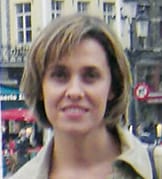
Juana Sánchez
CELTIC-NEXT representative
Centre for the Development of Industrial Technology (CDTI)
The Centre for the Development of Industrial Technology is the main R&D funding agency in Spain.
CDTI is a public business entity, answering to the Ministry of Science and Innovation, which fosters the technological development and innovation of Spanish companies. It is the entity that channels the funding and support applications for national and international RDI projects of Spanish companies. Therefore, CDTI contributes to improving the technological level of the Spanish companies by means of implementing the following activities:
› Financial and economic-technical assessment of R&D projects implemented by companies.
› Managing and fostering Spanish participation in international technological cooperation programmes.
› Fostering international business technology transfer and support services for technological innovation.
› Supporting the setting up and consolidating of technological companies.
CDTI employs over 350 people, three quarters of whom are engineers and graduates. Even though the bulk of the CDTI infrastructure is in Madrid, the Centre offers to Spanish companies a strategic network of CDTI SOST (Spanish Office for Science and Technology) offices in ten countries: Belgium, Brazil, Chile, China, India, Japan, Korea, Mexico, Morocco and the USA to promote the Spanish technology at international level, mobilize global financial resources and detect international market opportunities for Spanish high-tech companies with the aim of fostering the transnational technological cooperation in International Programs at bilateral or multilateral level, with special focus in the European programs, like Horizon Europe or Eureka.

CDTI premises in Madrid
Commitment with Eureka and CELTIC-NEXT – new funding procedure implemented
Addressing its international orientation, CDTI has strong support with the Eureka programme in general and with Eureka Clusters in particular. The bottom-up orientation of Eureka is fully aligned with CDTI’s philosophy.
CELTIC-NEXT, focussed on the telecommunications area, has become a Eureka Cluster with high interest in Spain. The Spanish CELTIC community ranges from large companies to small and medium-sized companies that regularly participate in its calls to improve their competitiveness. The impact of Celtic projects encourages Spanish companies to use this way to accelerate their potential business establishment in the telecommunications area.
In order to accelerate the time to contract of CELTIC projects, CDTI has a new funding procedure that forces Spanish companies to apply for funding as soon as Celtic projects are labelled. Spanish funding application is done in two phases: First, the leader of the Spanish sub-consortium applies a ‘Eureka request’ after the deadline of each CELTIC-NEXT call (margin: 15 days). Second, once the projects are labelled, each company involved in labelled projects presents the full memory (national request) with a margin of 20 days. This improved process will avoid long-term funding procedures for CELTIC projects and will shorten time-to-contract.
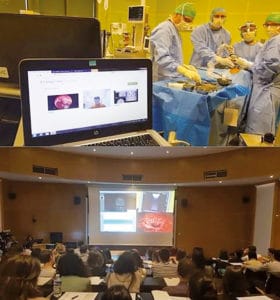
E3 medical test video sequence
Successful Spanish CELTIC project E3
The E3 project is a good example of CELTIC success based on three principles: OPEN platform that guarantees access EVERYWHERE for EVERYBODY. E3 has designed, implemented, tested and validated with final users (patients and professionals) an E2E (End-To-End) videoconference platform able to allow EVERYBODY (low-cost high-quality video conference & e-health services reusing in-home infrastructures) access to e-health services EVERYWHERE (both rural & urban areas, both patients and professionals) thanks to bandwidth adaptation techniques that allow simultaneous multipoint conferences with SD and HD.
These developments were tested and validated by doctors in 15 use cases over one common OPEN platform (adapted to point-to-point videoconferences and STB/HDTV functionalities), able to reuse in-home infrastructure (professional-to-patient scenarios and patient-to-patient scenarios).
E3 is a cross-domain project that uses Open Innovation to allow external partners (6 Spanish SMEs, 1 Polish SME, 1 Polish medical institution and 3 French medical institutions) to collaborate from project definition to test and validation easing go-to-market fit that has allowed to generate 12 new products and improve 14 products generating over 26.5 million euro revenue with 5.2X ROI since end 2020.
The main impact on Spanish partners has been on CALBOQUER SL (ASMEDIT) which launched Face-to-face+E3 developed solution to its 10 million customers with a 3 million euro revenue yearly increase. ASMEDIT is using STARFLOW (CLEVERNET) WAN Optimization solution to guarantee its professionals working from home connectivity, reliability and data in motion security.
Three start-ups have been created to commercialize E3 project developments, including SMART Health TV solutions in Spain which is participating in the ESA Space COVID19 Response Initiative as provider of telecare technology for CNR (Consiglio Nazionale delle Ricerche).
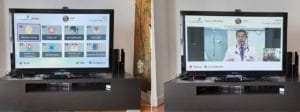
E3 project: User-friendly experience / Videoconference at Home TV
The E3 project has received 8 awards including: CELTIC-NEXT Innovation Award Winner (Heidelberg, 2020), EUREKA Excellence Award Winner (EUREKA Stakeholders Conference Amsterdam, 2019) and CELTIC-NEXT Excellence Award Winner (CELTIC-NEXT Event at EuCNC in Valencia, 2019).
Conclusion
CELTIC-NEXT is a strategic Eureka Cluster for Spanish companies that offers an excellent framework to improve their competitiveness in the telecommunications area at international level. Spain has many successful projects that have helped companies to establish as a reference in such competitive markets. CELTIC’s support is key for participants. Besides, its Core Group offers high level orientation to participants.
CDTI, aligned with CELTIC-NEXT and with Eureka Clusters in general, has optimized the funding procedure with CELTIC calls to accelerate the time-to-contract of CELTIC projects. This new procedure has already been implemented in the CELTIC-NEXT Spring Call 2021.
› Further information
› CDTI website – https://www.cdti.es
› E3 project page – https://www.celticnext.eu/project-e3/
Sn@pshot
Virtual exhibition booth
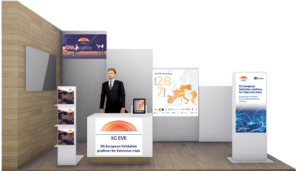
At this year’s fully virtual EuCNC & 6G Summit on 8–11 June 2021 also the booths in the exhibition were virtual. The image shows the virtual booth of 5G PPP project 5G EVE, which offered information via video and brochure as well as live access to a 5G EVE expert team.
Further information is available on the Joint EuCNC & 6G Summit website – https://www.eucnc.eu/
© Source: Wristify
5G-PERFECTA
5G and next generation mobile performance compliance testing assurance

Antonio Cuadra-Sánchez
Indra Minsait
The 5G-PERFECTA project has developed a 5G performance compliance testing assurance solution that measures the KPIs to show the real behavior of 5G network and services.
The challenge of CELTIC-NEXT project 5G-PERFECTA has been to develop the technology to assure the 5G service quality based on data processing, that is, to guarantee that the quality of 5G networks is aligned with the expectations of bandwidth, latency and other key performance indicators. A series of innovation activities have been settled in order to establish a reference architecture for supervising 5G networks by means of monitoring techniques that measure 5G performance indicators to evaluate the real performance of 5G networks. The consortium, led by Indra Minsait, gathers 16 partners from Industry & Telco, Research Centers, Academia and SMEs of Poland, Portugal, Spain, Sweden, and Turkey.
Motivation
The 5G infrastructure will deliver solutions, architectures, technologies and standards for the ubiquitous 5G communication infrastructures of the next decade. The following parameters are indicative of the new network characteristics to be achieved at an operational level: 10 times to 100 times higher typical user data rate and End-to-End latency of < 1ms. This new high-performance network needs to be effectively tested to assure that 5G technology is actually offered with high quality levels. For this purpose, we have developed a 5G performance compliance testing assurance solution that calculates KPI (Key Performance Indicators) to show the real behavior of 5G network and services. In addition, we have developed automated processes, tools and mechanisms ensuring 5G service quality, based on data processing and analytics approaches.
Scenarios and use cases
We have defined two main project scenarios and six use cases. The 5G Network Performance scenario provides the performance monitoring information and includes the testbed and measurement scope for 5G network performance analysis. The 5G Quality Assurance scenario provides the quality of service monitoring information, including the time-sensitive networking mechanisms, the deployment of critical services with performance guarantees, and the QoS observability for 5G. See in figure 1 the project scenarios and use cases.
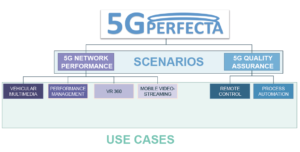
5G-PERFECTA scenarios and use cases
Impact
The 5G performance compliance testing assurance solution will help the digital providers (operators, service providers, applications providers, etc.) to evaluate how next generation services are performed on the 5G networks for different purposes: measuring of 5G network performance, validating the services on 5G networks, monitoring the QoS and QoE, launching of new applications, etc. In addition, there is a very strong focus on end users in 5G PERFECTA, since they are the ones who really benefit from the correct behaviour of the 5G network. For this purpose, we have considered the end-user perspective in the analysis of the performance of services on 5G networks.
Conclusion
The project will provide capabilities that improve efficiency in content delivery by means of user-oriented quality assurance capabilities, which will be able to impact a significant part of the 5G revenues expected for the following years. The outcomes of this project will allow network and service providers to deploy the right 5G infrastructure to run the most advanced video technology business cases before final 5G standardization is complete.
5G-PERFECTA will provide a monitoring platform that delivers real measurements of several new feasible services over the new generation networks, including beyond 4G and the 5G network, tested on a real infrastructure. These performance indicators will allow to determine the suitability of new mobile infrastructures, including 5G to support next generation applications in mobility, such as remote driving, medical care, logistics, retail, Smart Cities, Industry 4.0, etc.
You can find more information on 5G-PERFECTA at https://www.celticnext.eu/project-5g-perfecta/.
Public Authorities
This project has been co-funded in Spain by the Centro para el Desarrollo Tecnológico Industrial (CDTI), in Sweden by Vinnova, in Portugal by Portugal 2020, in Poland by Narodowe Centrum Badań i Rozwoju and in Turkey by Tübitak.
Relaunch of CELTIC-NEXT in revised Eureka Clusters Programme
Ambitious roadmap for 2021 – 2025

Xavier Priem
Director CELTIC Office
CELTIC-NEXT has been relaunched with a new, ambitious roadmap as part of the revised Eureka Clusters Programme. The relaunch is very timely in a world of dramatic change that requires novel ICT solutions addressing the economic, societal, and environmental challenges the Eureka member states and the world as a whole are facing.
The revised Eureka Clusters Programme
The CELTIC-NEXT Cluster application for the four-year period 2021-2025 was accepted, together with the Multi-Annual Plan for the Eureka Clusters, on 18th June 2021. This concluded a relaunch process that had started in June 2020. The new Eureka Clusters model is meant to encourage industry-wide collaboration and the forming of new innovation ecosystems. The revised Eureka Clusters Programme aims to align and synchronise the Clusters’ processes.
Since June 2020, the Eureka Clusters had already intensified their joint and synchronised activities, most visibly through two jointly organised AI calls in 2020 and 2021, which both mobilised a substantial number of excellent project proposals.
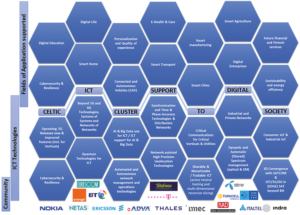
Topical areas of the CELTIC-NEXT Roadmap 2021–2025
Updated CELTIC-NEXT roadmap for 2021 – 2025
The theme of CELTIC-NEXT for the new period is: “Next-Generation Communications for a secured, trusted, and sustainable digital society”. All topics identified in the strategic roadmap of CELTIC-NEXT for the 2021–2025 period have been aligned under this theme. These topics are neither comprehensive nor prescriptive. In line with the bottom-up approach of CELTIC-NEXT, projects are free to explore any subject, as long as it is related to ICT and telecommunications.
A core part of the roadmap relates to the evolution of communication networks. The roadmap identifies the ongoing digitisation and automation of many aspects of our lives as fundamental drivers for transforming the communications network architecture and functionality. The shift to automation of everything is driven by current enabling technology trends like cloud-based services with dynamic, adaptive scaling, extensive virtualisation, novel software-defined automated solutions and ever-increasing wireless connectivity with a great promise of 5G, Beyond 5G, and the nascent 6G, and will require a redefinition of networking concepts and a new digital infrastructure involving radical shifts in technologies, architectures and business models to meet future digital needs.
The roadmap highlights a number of important trends and requirements expected to shape the projects and results of the CELTIC-NEXT Cluster in the coming years, including: pervasiveness, almost infinite network capacity, imperceptible latency, tera-scale things, cognitive operations, and perpetual protection.
Addressing the digital needs will require significant changes in network architecture and technology. Nine dimensions are identified in the roadmap towards an end-to-end convergent network architecture: 1. Massive-scale access, 2. Converged edge cloud, 3. Smart network fabric, 4. Universal adaptive core, 5. Programmable network operating system, 6. Network slicing, 7. Augmented cognition systems, 8. Digital value platforms, and 9. Dynamic data security.
Further related areas of the roadmap beyond communication networks in the narrow sense include: cybersecurity, artificial intelligence and big data, ICT solutions for sustainability, ICT-enabled health and wellness, new solutions for consumption and production, smart cities and smart territories, smart transport, smart energy, smart agriculture, smart home and smart building, digital enterprise and digital education, content, entertainment and gaming, fintech, and digital life services.
Many of the topics identified in the roadmap go across several Eureka Clusters, which is intentional, as ICT is at the core of innovation in all vertical sectors. In line with the concept of the revised Cluster Programme, CELTIC-NEXT will use these cross-Cluster topics as opportunities for creating synergies and increasing impact across the whole programme. Only in this way can CELTIC-NEXT and the other Clusters in the programme continue delivering top-level industry-driven innovations addressing the needs of economy, society and environment. In line with this cross-Cluster collaboration spirit, CELTIC-NEXT is one of three Core Technologies Clusters, together with partner Clusters ITEA (software) and Xecs (hardware). As a Pillar Cluster, CELTIC-NEXT supports the two more application-based Clusters EUROGIA2020 (low-carbon energy technologies) and SMART (manufacturing).
Excellence targets
CELTIC-NEXT has defined a set of excellence targets in order to keep its activities focused on achieving substantial measurable impacts. These targets are divided into three areas:
1. Technical excellence targets
› Accelerate the deployment and take-up of new advanced end-to-end ICT services, employing the new network concepts of 5G and leading to the implementation of 6G in Europe
› Actively facilitate the adoption of those ICT technologies by all targeted Verticals into their communities, business models and processes
2. Economic excellence targets
› Consolidate the position of European ICT manufacturers and service providers within Europe and on the global market
› Contribute to all Eureka Communities tackling the technological and socio-economic challenges in a holistic way by considering the end-to-end perspective of new communications solutions
3. Societal and environmental excellence targets
› Investigate where advanced communications can reduce carbon footprints for many vertical sectors
› Assist European nations and industry to access the societal benefits and returns of being at the forefront of the new digital society
› Consolidate the European sovereignty in ICT technologies and services as well as other critical infrastructures relying on ICT infrastructures, like the Energy Grid
These targets are highly ambitious and require close collaboration between the private and the public sector. The revised Eureka Clusters Programme provides the structure and the ecosystem to achieve them.
High number of proposals in Eureka Clusters AI Call 2021

The second Eureka Clusters AI Call, which was launched on 1st March, has attracted a high number of project proposals. By the deadline of 28th June, 43 proposals had been submitted. These proposals represent a total commitment of 2,518 person years by international researchers and developers from large enterprises, SMEs, research & technology organisations, and academia.
The aim of this Call is to boost the productivity and competitiveness of European industries through the adoption and use of AI systems and services. 14 Eureka countries have allocated budget to support ground-breaking Artificial Intelligence innovations. The Call has been jointly organised by the following Eureka Clusters: CELTIC-NEXT, EUROGIA, ITEA, PENTA–EURIPIDES, and SMART. For 9 of the submitted proposals, CELTIC-NEXT has been selected as the primary Cluster. For 6 additional proposals, CELTIC-NEXT has been selected as the secondary Cluster. This means that CELTIC-NEXT has been selected in more than a third of the proposals among the 5 Clusters.
The proposals are now being evaluated. Results are expected to be known by the end of September.
› Further information
Eureka Clusters AI Call website – https://eureka-clusters-ai.eu
